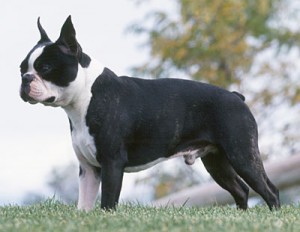 The Boston Terrier is an American breed that was created by crossing the French Bulldog and the White English Terrier. This breed originally developed as a fighting dog, however, this breed is not aggressive towards people.
The Boston Terrier is an American breed that was created by crossing the French Bulldog and the White English Terrier. This breed originally developed as a fighting dog, however, this breed is not aggressive towards people.
The Boston Terrier is a small dog that only stands between 10 and 16 inches tall. Its weight usually stays between 11 and 24 pounds. Their coats are short and silky. This breed comes in two color varieties: a black coat with white markings or a brindle coat with white markings. Some of the health issues that this breed is susceptible to are cataracts, breathing problems, and whelping difficulties.
The Boston Terrier can often have a large variety in personality with one member of a litter having certain traits and another with completely different traits. As these dogs can have dominant personalities it is important to start early with obedience training.
 Boston Terriers originated in the United States. They are small but compact dogs. They determined and tough. However, they are also faithful and affectionate companions.
Boston Terriers originated in the United States. They are small but compact dogs. They determined and tough. However, they are also faithful and affectionate companions.
Origin of the Boston Terrier
The Boston Terrier originated in the United States in 1870. Originally, it was a cross between an English Bulldog and an English White Terrier. They were made smaller down in size by interbreeding the original lines with smaller females until finally, an offspring was interbred with one or more French Bulldogs. The resulting offspring became the foundation of the modern Boston Terriers.
Boston Terrier Appearance and Abilities
The Boston Terrier is a lively and highly intelligent breed with an excellent disposition. They are tough as nails but known to be warm and loyal. The Boston Terrier is a very strong dog and has great stamina.
Their build is compact and well-muscled and they have very distinct faces. The muzzle is short and wide and their large round eyes are set apart from each other. Their neck is slightly arched and their chests are broad their limbs are straight and muscular.
The coat of a Boston Terrier is usually short with a fine texture that comes in brindle and white, or black and white, and some are brown and white.
Temperament and Tendencies of the Boston Terrier
The Boston Terrier is a fairly active dog. The breed has an excellent disposition and a high degree of intelligence. They are enthusiastic but usually very well-mannered.
Boston Terriers are very eager to please and learn. They thrive on positive reinforcement but are especially sensitive to harsh methods of training. Boston Terriers are very sensitive to the tone of your voice. Don’t shout at them, it will make them feel miserable and may produce anxiety. They may try to take the alpha role if you are not clear with who is the leader.
They are very friendly creatures and are great with children and other animals as well. However, the breeds’ behavior may vary a lot. Since they are bred to fight, they can become stubborn and aggressive, but with extensive socialization, they can become very pleasant companions.
They may bark but they will usually only bark if they sense something unusual. Barking at strangers incessantly is not a natural Boston Terrier trait. Usually, they consider everyone a potential friend.
Boston Terrier Training and Care
In order to train Boston Terriers effectively, the owners must display leadership. With meek and inconsistent owners, they tend to become too willful. They will begin to believe they are running the show. They will become dominant and treat their owners as subordinates.
Socialization is also very important for Boston Terriers. Highly socialized Boston Terriers turn out to be affectionate, friendly, and refined. Boston Terriers are very alert dogs. If trained to be guard dogs, they can excel with no problem.
Make sure to correct unwanted behavior and establish leadership as early as possible.
House training Boston Terriers may be challenging. Generally, they have difficulty because of their small bladders, especially when they are still young. Yet, with consistency, they can adapt not to urinate or defecate in inappropriate places.








7 Responses to “How to Train a Boston Terrier”
MY BOSTON IS NOTHING LIKE THAT!! He barks at strangers, bites feet and hands, and occasionally snarls. We know he only wants to play, but we dont know how to correct it! Your post doesnt tell anyone HOW to train a Boston, it just says what the rewards of training them are! PLEASE let me know how to fix his behavor! By the way, he behaves perfectly if he sees you have a treat, and he is 6 months old.
There are hundreds of pages on the site for training everything you’d want. Enter in your name and email on any page and you’ll get a free course. Here are some resources- https://www.dogbehavioronline.com/train-a-dog-not-to-bite/ https://www.dogbehavioronline.com/puppy-biting/ https://www.dogbehavioronline.com/how-to-stop-puppy-biting-puppy-manners/
There are THREE colors of Boston Terriers (registerable - there are countless other colors considered to be faults). The standard tuxedo, which is black and white, brindle and white, and SEAL AND WHITE. Seal appears black until light hits the coat, them it turns more of a red color. Brown and white Bostons are often called “seals,” but they absolutely are not.
These dogs tend to be high-strung, but they are easily trainable. I have never come across an aggressive BT, though aggression exists in all breeds due to owners who haven’t a clue how to train a dog.
To the person above - your dog is running the show. You need to get on top of this behavior NOW. I only train using positive methods; check out Positively, by Victoria Stilwell.
I’ve worked with dozens of Bostons with aggression problems. They all had good owners.
The purely positive method is perhaps the worst and least effective thing to hit dog training in 25 years.
Greetings Ty,
A well written and informative article, although Rachel does have a point about the title. I adopted my BT at seven months when his owners didn’t want him anymore. The information above helped in understanding his personality. He is the craziest thing I have ever seen and provides hours of entertainment.
I think the best part about positive training is…You must figure out WHY your dog is behaving a certain way. Trying to figure out why my dog thought it was a great idea to eat the petunias, is like trying to figure out why a two year old eats playdoh. There is no answer.
Over the years I have had big dogs, and small dogs, have read training techniques from beating your dog to clicker training. I was watching one of my first VHS tapes on training, and actually cringed when the dog was ripped off its feet by the collar. I would assume that all have some measure of effectiveness. I would have to say the least effective part of training is the inconsistency with those of us who don’t have the time to devote, or lose interest after a while. I may not have had the best trained dogs, but they passed as well behaved and loved to death.
I am eagerly going to peruse your site and will let you know how it goes.
I have a male BT that is 1 year & 10 months old. We got him when he was 8 weeks old so he’s been with us only. I am concerned about him and not sure how to handle. When we first got him I treated him like a baby; cuddled him, played with him all the time; all the loving things. However I became pregnant when he was 7 months old and I did’t always have the energy to do all the things I used to with him. Well, then the baby came, we moved to a new house, our other dog Ruby (a german short-haired pointer) went to live with a friend of ours because she was too much to handle. Long story short, he’s been through a lot for dog and my husband has yelled at him numerous times. Ringo our BT, has become scittish, not as playful, refuses at times to go outside to pee and will pee in the house, and now he pee’s even if you reach down to pet him. I’ve explained to my husband that he needs to be cautious of Ringo and that he is a sensitive dog which is why I feel he pee’s all the time. I just don’t know what to do to help correct this problem. I am getting fed up with wiping and cleaning up messes every day! Any help please???
For starters, from your brief description is sounds like you are both doing things wrong. There is nothing wrong with cuddle, play, and ‘loving things’. Typically, though, when I hear those descriptors they tend to go along with a lack of structure and proper discipline.
On the flip side, proper discipline does not involved yelling and getting angry.
Here is another article where I give a few tips and ideas-
https://www.dogbehavioronline.com/submissive-urination-and-obedience-training/